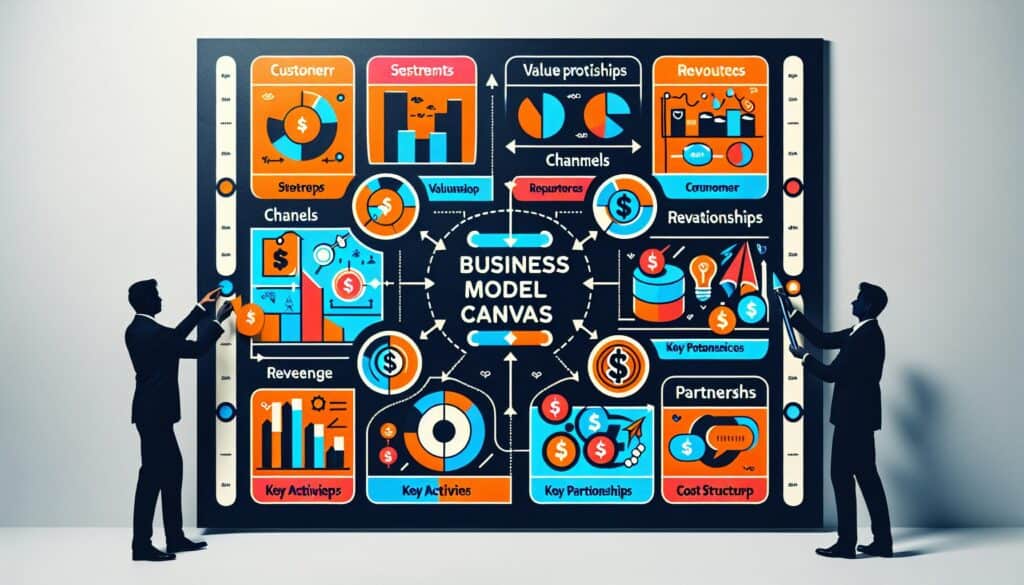Visuelles Beschreiben, Entwerfen, Hinterfragen und Pivotieren eines Geschäftsmodells anhand von neun Schlüsselbausteinen: Kundensegmente, Wertversprechen, Kanäle, Kundenbeziehungen, Umsatzströme, Schlüsselressourcen, Schlüsselaktivitäten, Schlüsselpartnerschaften und Kostenstruktur.
- Methodologien: Ergonomie
Business Model Canvas

Business Model Canvas
- Agile Methodik, Funktionsübergreifende Zusammenarbeit, Kundenerfahrung, Design Denken, Innovation, Schlanke Fertigung, Projektmanagement, Wert-Angebot
Zielsetzung:
Wie es verwendet wird:
- Unternehmer und Strategen nutzen sie als gemeinsame Sprache, um bestehende Geschäftsmodelle zu skizzieren oder neue zu entwickeln und so strategische Gespräche und Innovationen zu erleichtern.
Vorteile
- Bietet eine ganzheitliche Sicht auf das Unternehmen, einfach und visuell, erleichtert die Kommunikation und Zusammenarbeit, fördert das systematische Denken.
Nachteile
- Kann für komplexe Unternehmen zu simpel sein, validiert Annahmen nicht von sich aus (erfordert externe Tests), kann statisch sein, wenn sie nicht regelmäßig aktualisiert wird.
Kategorien:
- Wirtschaft, Ideenfindung, Produktdesign, Projektmanagement
Am besten geeignet für:
- Entwicklung, Visualisierung und Iteration von neuen oder bestehenden Geschäftsmodellen auf strukturierte und kollaborative Weise.
The Business Model Canvas serves various applications across sectors such as technology, healthcare, and consumer goods, making it versatile for both startups and established enterprises looking to innovate or pivot. Organizations often use it in early project phases, such as ideation and feasibility studies, where cross-functional teams—including designers, engineers, and marketers— collaborate to explore new product offerings or refine existing ones. This methodology allows for the development of customer Menschen and value propositions, grounding discussions in real user needs and market challenges, which is particularly valuable in design thinking initiatives. Participants can work through issues related to revenue streams, distribution channels, and customer relationships, integrating stakeholder feedback directly into the model. Industries like fintech leverage the canvas to visualize complex regulatory requirements alongside innovative service delivery mechanisms, while companies in sustainable energy focus on environmental impacts and social value. The structure of the canvas encourages iteration, enabling teams to quickly adapt their approaches based on testing or market feedback, making it a dynamic tool for planning and strategy alignment. In workshops, the Business Model Canvas creates an engaging environment, where ideas can be swiftly sketched out and explored, leading to enhanced communication and collaboration within diversely skilled teams.
Die wichtigsten Schritte dieser Methodik
- Identify customer segments and define target groups.
- Clarify value propositions for each customer segment.
- Outline channels for customer communication and delivery.
- Specify customer relationships and engagement strategies.
- Detail key revenue streams from each segment.
- Identify key resources required to deliver the value propositions.
- List key activities that must be performed to create value.
- Define key partnerships that enhance business capabilities.
- Establish the cost structure associated with the business operations.
Profi-Tipps
- Integrate metrics directly into the canvas; quantify each segment for a clear understanding of performance and value generation.
- Conduct regular "Canvas Jam" sessions with cross-functional teams to encourage diverse perspectives and innovative ideas.
- Utilize digital tools to create an interactive Business Model Canvas that allows real-time updates and stakeholder engagement during brainstorming sessions.
Verschiedene Methoden lesen und vergleichen, Wir empfehlen die
> Umfassendes Methoden-Repository <
zusammen mit den über 400 anderen Methoden.
Ihre Kommentare zu dieser Methodik oder zusätzliche Informationen sind willkommen auf der Kommentarbereich unten ↓ , sowie alle ingenieursbezogenen Ideen oder Links.
Historischer Kontext
1960
1980
1983
1990
1995
2000
2010
1950
1980
1980
1986
1994
1995
2000
(wenn das Datum nicht bekannt oder nicht relevant ist, z. B. "Strömungsmechanik", wird eine gerundete Schätzung des bemerkenswerten Erscheinens angegeben)














Verwandte Artikel
Master Production Schedule (MPS)
Massenanpassung
Marketing-Trichter
Marketing-Audit
MAPO-Index (Bewegung und Unterstützung von Krankenhauspatienten)
Fertigungsressourcenplanung (MRP II)